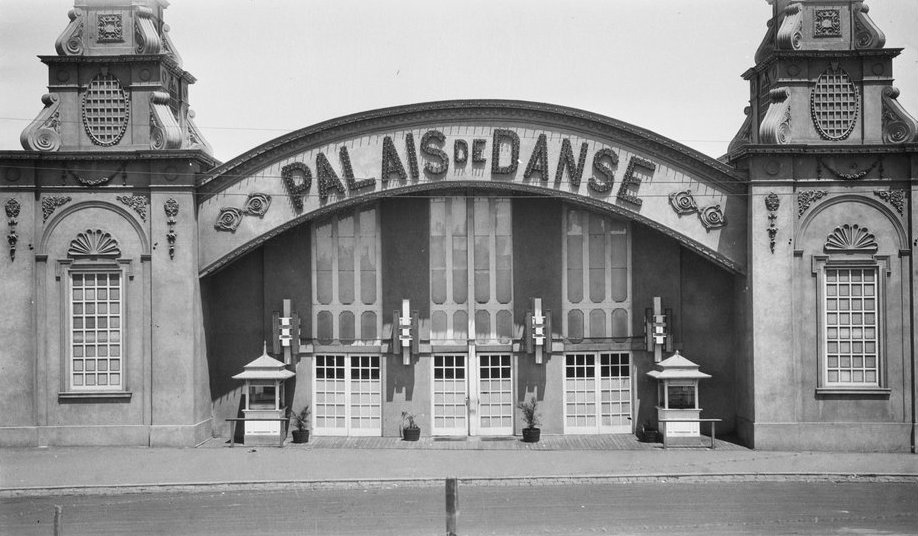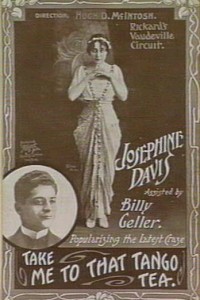‘When an Argentinean dance called the tango arrived in Melbourne in 1913, the wowsers were shocked by dancers who danced cheek-to-cheek and whose legs and arms pressed against each other in an erotic embrace.’ [1]
Tango dancing has been in Australia for over a century. St Kilda’s Palais de Danse hosted the first, or possibly second, tango dance on December 20, 1913, according to the ominously titled book Dancing to damnation? [2] The Argus reported that the dancers performed …’a series of reverse movements and posings, requiring lightness of foot and suppleness of body. They had eccentric grace without the least trace of anything suggestive or offensive.’
[Buildings in St.Kilda], H94.149/1
The performance caused wide spread consternation, but the Mayor of St Kilda declared, ‘I am absolutely in favour of dancing and also realise that abuse is possible in any direction.’ [3] However Mrs Hay, wife of Commissioner Hay, of the Salvation Army was not convinced, ‘It may be quite satisfactory, in a society where people are cultured and have self-control, but for the masses it arouses passion and desires which otherwise would remain dormant…It is often the dance-room and the first glass of wine…that mark the first step towards heartbreaks, disgrace, and our maternity homes.’ [4]
Pocket tango guide: and guide to the other dances.
Melbourne was not the only city debating the tango. The Wangaratta Chronicle reported the dance’s demise in London, whilst in Paris the Cardinal thought the dance ‘offensive to morals.’ The Horsham Times tells of an Adelaide Clergyman speaking out against the ‘voluptuous, sensuous, amorous’ dancing. Meanwhile Mr R Clack, of Melbourne’s Young Men’s Christian Association regards the dancing as a temptation which should be avoided.[5] Meanwhile in Rome, the Pope went even further, placing the dance ‘under the ban of his holy office.’ Even Queen Mary banned the tango from the Palace.
Josephine Davis assisted by Billy Geller, popularizing the latest craze take me to that tango tea, H36145/57
Defence of the tango came from Miss Jenny Brennan, mistress of the ballet of Melbourne’s Her Majesty’s Theatre, ‘The tango is a delightful, graceful dance—of course, I mean the tango which is danced in the ballroom.’ [6]
The Tango pocket guide tried to explain the craze, ‘The tango, as properly danced to-day, has been shorn of all its objectionable features, and there is not the slightest impropriety about any single movement of the tango as it is danced now.’
The Library holds many tango resources including music scores, sound recordings and books. If you’d like to risk damnation, the tango centenary will be celebrated at Fitzroy Town Hall on August 17.
Bibliography
[1] Jackling N, 2009, Dancing to damnation? Harold Wood and John Woodhouse in the fight to lift the ban on dancing on Methodist Church property, Uniting Church Historical Society, Elsternwick, p42
[2] Ibid, p86, vii
[3] Sternberg, F, 1914, ‘Should the Tango be debarred?’ Everyladys journal, Feb 1914, p71
[4] Ibid, p86
[5] Ibid, p86
[6] Ibid, p86
Written by Paul Dee
Australian History and Librarian





Thank you for such an interesting blog. As one of the organisers of Milonga 100, the event celebrating the 100th Anniversary of Tango in Australia, on August 17th at Fitzroy Town Hall, I was grateful to see recognition of the centennial.
As far as I have been able to establish tango was first seen in Australia in Adelaide, July 1913 with Tango Tea Dances held at the Tivoli consisting of lessons, fashion parades and demonstrations. HG Wells said in 1913 “This is the year of the Tango” What an exciting era.
Dianne
Congratulations from Johannesburg, South Africa on your centenary.
Jenny Brenan taught Classical Ballet – also called Operatic Dance – to my mother Iris Phillips who at age 13 joined Anna Pavlova’s company. Talented Jenny Brennan, a Catholic Ladies College East Melbourne Alumna, had played Trilby in the first Southern Hemisphere production of the eponymous George du Maurier play. She and her sister Eileen are considered founders of the Australian section of what became the R.A.D., the Royal Academy of Dancing.